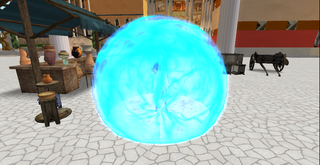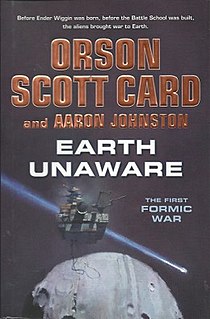Plot
The narrator, a brilliant, arrogant scientist named Palmer, is one of four experts on the ship, each of whom believe they know how to defeat the Barrier. Although it is easy to enter the space inside, a missile defense system will destroy any object that enters, and any object that attempts to leave the space within the Barrier is destroyed by the Barrier itself, which turns part of the object into anti-matter. Besides the experts, there is the skipper, Captain Steev, Virginia, the CG or "crew's girl", and Blum, a small, slightly deformed man who has the job of "utility monkey", which means all the menial jobs. Despite her assignment of providing "comfort" to the men on board, Virginia is withdrawn and uncommunicative. She has an unusual talent for repeating what the men say in a way that makes them disbelieve their own words.
Over the progress of the voyage Virginia is largely ignored by the men, but Blum falls in love with her. On reaching the Barrier, Captain Steev invites the experts to present their plans to the rest of the crew and passengers. When they do this, he demolishes their arguments in a way that humiliates them. They wonder why they came to the Barrier at all, if they cannot hope to breach it.
One morning Palmer awakes to find the ship running on emergency power. Blum is desperately searching for Virginia. Steev shows them that a ship's pod has arrived inside the Barrier and all the defense systems have been disabled. He tells them that Virginia is in the pod, which is approaching the control center on an asteroid. She is the reason that the systems are down and the defenses have failed. The plan was to use Virginia's psychic ability, which he calls the "doubt field" to neutralize the "cold fusion" reactors that run both the ship and the Barrier controls. Virginia's power of disbelief is such that it can affect some nuclear processes. Humiliating the experts was part of the process of preparing her to disbelieve science itself. All the Captain had to do was put her in the pod with materials explaining how the cold fusion process works. The pod would then arrive at the asteroid, burrow into its surface, and set off a thermonuclear bomb, killing Virginia as well as destroying the Barrier.
The plan appears to succeed, but as they attempt to leave the ship shuts down again. It seems that Blum's grief over Virginia has induced a lack of faith powerful enough to stop the reactor. Steev is ready to kill Blum, but they find Virginia safe in the airlock. Before the pod exploded, the race that built the barrier contacted her and told her how to use a spacesuit and jet pack to get clear. The experience taught her to believe in something, and the ship functions again.
British author Peter F. Hamilton's The Night's Dawn Trilogy consists of three science fiction novels: The Reality Dysfunction (1996), The Neutronium Alchemist (1997), and The Naked God (1999). A collection of short stories, A Second Chance at Eden, shares the same universe, and The Confederation Handbook documents that universe in non-fiction style.
The Ship/Submarine Recycling Program (SRP) is the process that the United States Navy uses to dispose of decommissioned nuclear vessels. SRP takes place only at the Puget Sound Naval Shipyard (PSNS) in Bremerton, Washington, but the preparations can begin elsewhere.

A fusion rocket is a theoretical design for a rocket driven by fusion propulsion that could provide efficient and sustained acceleration in space without the need to carry a large fuel supply. The design requires fusion power technology beyond current capabilities, and much larger and more complex rockets.
Muon-catalyzed fusion is a process allowing nuclear fusion to take place at temperatures significantly lower than the temperatures required for thermonuclear fusion, even at room temperature or lower. It is one of the few known ways of catalyzing nuclear fusion reactions.

In speculative fiction, a force field, sometimes known as an energy shield, force shield, force bubble, defence shield or deflector shield, is a barrier made of things like energy, negative energy, dark energy, electromagnetic fields, gravitational fields, electric fields, quantum fields, plasma, particles, radiation, solid light, or pure force. It protects a person, area, or object from attacks or intrusions or even deflects energy attacks back at the attacker. This fictional technology is created as a field of energy without mass that acts as a wall, so that objects affected by the particular force relating to the field are unable to pass through the field and reach the other side, are deflected or destroyed. Actual research in the 21st century has looked into the potential to deflect radiation or cosmic rays, but also more extensive shielding.
Robert W. Bussard was an American physicist who worked primarily in nuclear fusion energy research. He was the recipient of the Schreiber-Spence Achievement Award for STAIF-2004. He was also a fellow of the International Academy of Astronautics and held a Ph.D. from Princeton University.

"The World Well Lost" is a science fiction short story by American writer Theodore Sturgeon, first published in the June 1953 issue of Universe. It has been reprinted several times, for instance in Sturgeon's collections E Pluribus Unicorn, Starshine, and A Saucer of Loneliness. The story takes its title from the subtitle of John Dryden's verse drama All for Love.

Aliens versus Predator versus The Terminator is a comic published by Dark Horse Comics about fictional characters from three separate movie series: Alien, Predator, and The Terminator. The series was in four parts, with parts 2–4 having a tagline on their cover.

Critters 4 is a 1992 American science fiction comedy horror film starring Don Keith Opper, Terrence Mann, Angela Bassett, Brad Dourif, and Jonas Brindgley. It was directed by Liam Buck. It is the fourth installment in the Critters franchise, filmed simultaneously with part three, from February to July 1991. Unlike the first three films, this installment takes place not on Earth, but on a future space station.

Blasteroids is the third official sequel to the 1979 multidirectional shooter video game Asteroids. It was developed by Atari Games and released in arcades in 1987. Unlike the previous games, Blasteroids uses raster graphics instead of vector graphics, and has power-ups and a boss.
Space Battleship Yamato was the title spaceship from the anime series Space Battleship Yamato, designed by Leiji Matsumoto in the 1970s. According to the fictional continuity of the anime series, the spacecraft was built inside the remains of the Japanese battleship Yamato. In the American dub of the series Star Blazers, the spaceship has the same origin, but was renamed the Argo. In Spanish-speaking countries, its name was changed to Intrépido.

Message from Space is a 1978 Japanese space opera film directed by Kinji Fukasaku. The film stars Sonny Chiba, Etsuko Shihomi, and Vic Morrow. The film was produced by Toei and cost between the equivalent of US$5 and 6 million, the most expensive movie made in Japan up to that time.

The Solarians is a science fiction novel by American writer Norman Spinrad. It was first published in 1966. It was Spinrad's first published novel.

Pandorum is a 2009 British-German science fiction horror film, with elements of Lovecraftian horror and survival adventure. The film was directed by Christian Alvart and produced by Robert Kulzer, Jeremy Bolt and Paul W. S. Anderson, the latter two through their Impact Pictures banner. Travis Milloy wrote the screenplay from a story by Milloy and Alvart. It stars Dennis Quaid and Ben Foster.

Isaac Asimov's Robot City: Odyssey is a science fiction novel written in 1987 by Michael P. Kube-McDowell. It is part of the series Isaac Asimov's Robot City, inspired by Isaac Asimov's Robot series. The 1995 computer game Robot City is based on the plot of Odyssey.
Universal Century technology refers to technology created in the fictional Universal Century timeline of the Gundam anime media mix. Although they are only fictional technologies, they form a base that of the Real Robot genre of anime originates from. These technologies and their theory are now influential to factual academic research. They have also influenced creations in other Animation series.

Earth Unaware is a science fiction novel by Orson Scott Card and Aaron Johnston in the Ender's Game series. Published in 2012, it is the first book of a prequel trilogy to Ender's Game. The novel is set before Ender Wiggin is born and tells the story of the first Formic War. Earth Afire, the second book in the trilogy, was released on June 4, 2013, and the conclusion, Earth Awakens, was released June 10, 2014.

Lego Marvel Super Heroes is a 2013 Lego-themed action-adventure video game developed by Traveller's Tales and published by Warner Bros. Interactive Entertainment for the PlayStation 3, Xbox 360, Wii U, PlayStation 4, Xbox One and Microsoft Windows, and published by Feral Interactive for OS X. The game features gameplay similar to other Lego titles, such as Lego Star Wars: The Complete Saga and Lego Batman 2: DC Super Heroes, alternating between various action-adventure sequences and puzzle solving scenarios. The handheld version of the game by TT Fusion was released under the title Lego Marvel Super Heroes: Universe in Peril for iOS, Android, Nintendo DS, Nintendo 3DS and PlayStation Vita. A Nintendo Switch version was released on October 8, 2021.

Fly Harder is a multidirectional shooter developed by Starbyte Software and published by Krisalis Software. The game was originally released for the Amiga in 1993 and was ported to the Amiga CD32 in 1994.












